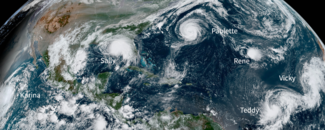Putting the most active season in recorded history in context

One of the most remarkable characteristics of the 2020 North Atlantic hurricane season was its extremely high level of activity. The season saw 30 named storms (storms with winds of 39 mph or greater) develop, including 13 hurricanes (storms with winds of 74 mph or greater) and six major hurricanes (storms with winds of 111 mph or greater). This makes 2020 the most active season on record and breaks the previous record of 28 storms set back in 2005, which includes an unnamed subtropical storm discovered in post-season analysis.
Other seasonal records of note:
- Twelve separate storms made landfall in the contiguous U.S. during the 2020 season, beating the previous record of nine set in 1916.
- Of those 12 landfalls, five occurred in the state of Louisiana, setting another record for most landfalls in a single state in a season.
- Ten storms formed in the month of September, the most in any single month on record.
- 2020 was only the second year in history that Greek letter names were used as storm names after exhausting the usual rotating list of 21 names (2005 is the only other year this has been done).
- Two major hurricanes, Eta and Iota, formed in the month of November, marking the first time this has happened.
- Iota also attained Category 5 intensity on November 16, 2020, making it the strongest storm to occur so late in the season.
- 2020 marked a record fifth consecutive year with at least one Category 5 hurricane.
Why was the 2020 North Atlantic Hurricane Season so active?
According to NCEI scientist Jim Kossin, the biggest contributor to the hyperactive 2020 Atlantic hurricane season was by far the much-warmer-than-normal ocean temperatures.
On top of the very warm ocean temperatures, La Niña conditions persisted this year in the Pacific Ocean, which tends to lower vertical wind shear and make the Atlantic Ocean more conducive to tropical storm formation. In addition, other random factors likely played some role in the extreme level of seasonal activity, such as short-term atmospheric pattern variations in both the midlatitudes and tropics.
An Extended Season
2020 marked a record sixth consecutive year with named storm formation before the “official” start of the North Atlantic hurricane season on June 1. According to Kossin and his colleagues’ research, in a year with warmer-than-normal ocean temperatures, this is to be expected. “We found that the hurricane season length, on average, increases by about 40 days per one degree Celsius of anomalously warm ocean: 20 days earlier and 20 days later.”
This pattern of “early” storms serves as a reminder that the North Atlantic hurricane season dates of June 1 through November 30 represent the most likely time frame for tropical cyclone development in the North Atlantic, and do not place hard boundaries on when tropical cyclones can form. “Simply put, when the oceans are warm enough, tropical storm formation can commence. If they're warm enough in May or in December, and the other factors that control formation aren't too hostile, then storms will form in those months.”
Rapid Intensification
A unique feature of the 2020 season was the large number of storms that rapidly intensified—10 of the 13 hurricanes that formed this season underwent rapid intensification, and a few of those underwent explosive intensification. This ties the previous record number of rapidly intensifying storms set in 1995.
Rapid intensification is an increase in a tropical cyclone’s maximum sustained wind speed of at least 35 miles per hour in a 24-hour period. Rapidly intensifying storms can be quite dangerous and difficult to forecast, posing an increased risk to people in their path. If these storms’ wind speed increases significantly just before landfall, that leaves little time for appropriate preparations. Kossin again mentions the very warm ocean temperatures this year as the most likely factor responsible for the unusually high number of rapid intensification events.
Slowing of Storms
Another pattern to note in the 2020 season is that two hurricanes stalled their forward motion as they were making landfall: Hurricane Sally along the Gulf Coast and Hurricane Eta in Nicaragua. Both events were especially devastating because of stalling.
These storms follow a trend toward slower-moving hurricanes over the United States that has been documented recently by Kossin and others: In 2019, Hurricane Dorian stalled over the Bahamas, Hurricane Florence stalled over the Carolinas in 2018, and in 2017, Hurricane Harvey stalled over Texas. Kossin notes that the repeated slowdowns also seem to have some link to anthropogenic climate change.
A Historic Season
The 2020 North Atlantic hurricane season was undoubtedly historic, with unusually warm ocean temperatures being the main factor responsible for the long duration of the season and the record-breaking number of storms that formed. Other storm trends noted this season, such as rapid intensification and stalling upon landfall, contributed to the danger and destruction of this hurricane season. These patterns underscore the North Atlantic Basin’s increasing vulnerability to tropical cyclone impacts.



